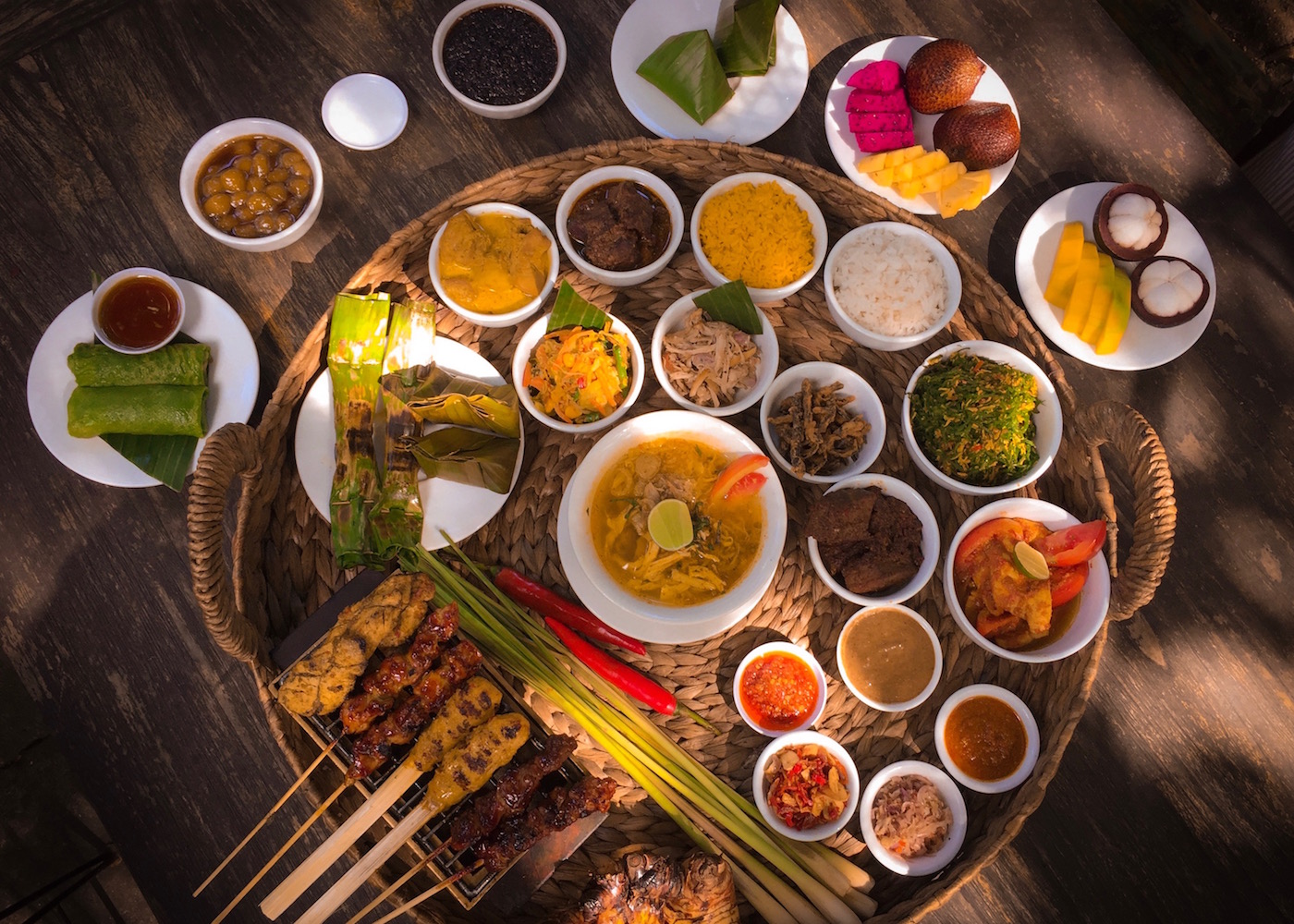Bali Local Food Guide: Best Local Food In Bali
Best Local Food in Bali
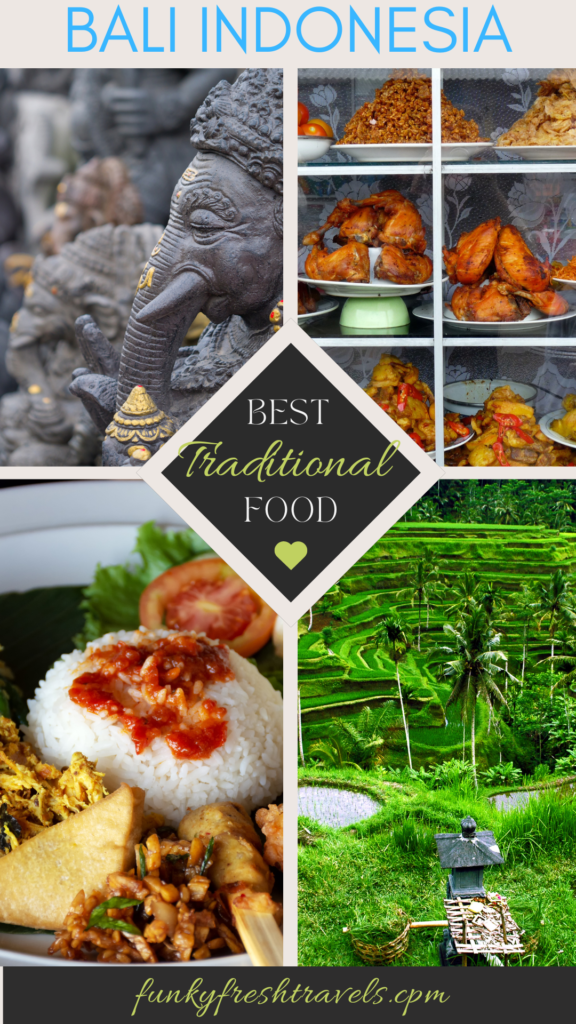

Indonesia, an archipelago nation renowned for its diverse cultures and breathtaking landscapes, offers an equally rich and varied culinary experience. Among its many islands, Bali stands out as a true food paradise, captivating visitors with its unique flavors, traditional cooking methods, and vibrant dining scene. Unlike many other parts of Indonesia where Islamic dietary laws prevail, Bali’s predominantly Hindu population allows for a wider array of dishes, particularly those featuring pork, making it a distinctive culinary destination. This comprehensive guide will delve into the heart of Balinese cuisine, exploring its best local dishes, the beloved “warung” culture, and essential tips for a safe and enjoyable gastronomic adventure, ensuring you discover the best food Bali has to offer.
Don’t forget to check our complete guide about Bali, Canggu, Seminyak and other cities . Restaurants, Yoga, breakfasts, bars … And much more !
Bali: The Food Paradise Unveiled

Bali is a land of sensory delights, where ancient temples, serene beaches, lush rice paddies, and vibrant cultural performances coexist harmoniously. While the island’s natural beauty and spiritual allure are undeniable, its culinary offerings are equally captivating. Visitors often rave about the distinctive and pleasant variety of flavors that define Balinese food, a cuisine that beautifully blends indigenous ingredients with influences from Indian, Chinese, and Malay culinary traditions. This unique blend contributes to what many describe as the best local food Bali has to offer.

The island’s unique position as a Hindu-majority region within a predominantly Muslim country has significantly shaped its food landscape. This allows for the prominent inclusion of pork dishes, a rarity in most other Indonesian provinces, giving rise to iconic dishes like Babi Guling. From humble street food stalls to upscale eateries, Bali caters to every palate and budget, promising an unforgettable gastronomic journey for every traveler exploring the unique Bali diet.
Understanding the Warung: The Heartbeat of Balinese Local Food

Before diving into specific dishes, it’s crucial to understand the concept of a “warung.” A warung is more than just a small, family-run restaurant; it’s a cultural institution in Indonesia, a place where locals and tourists alike gather to savor authentic, affordable, and often home-cooked Indonesian food. These local restaurants are the true backbone of the Balinese culinary scene.
What is a Warung?

Warungs are typically found in bustling local markets, vibrant shopping areas, and conveniently close to popular tourist attractions. They are usually open from morning till night, serving breakfast, lunch, and dinner. The charm of a warung lies in its simplicity and authenticity. Often open-air, they provide a casual and relaxed atmosphere, perfect for people-watching and soaking up the local culture. The Balinese people often frequent these establishments for their daily meals, testament to their quality and affordability.
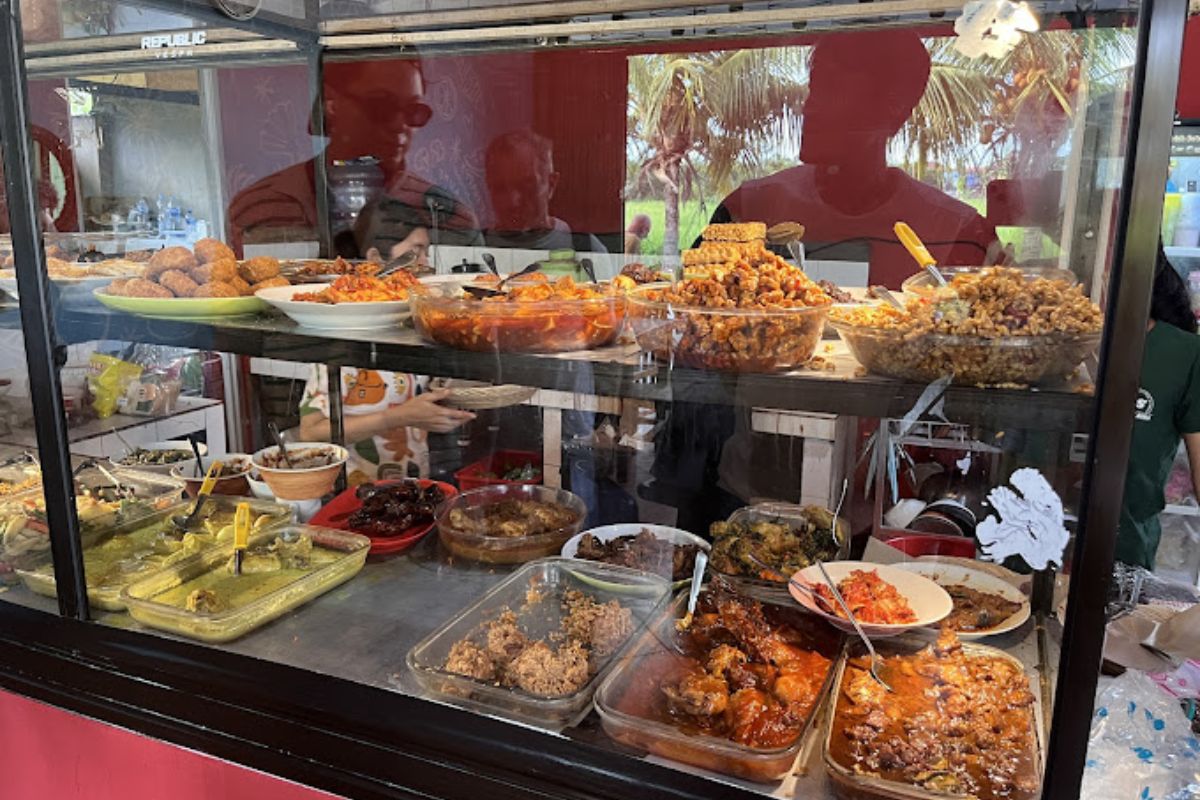
The food at warungs is generally cooked over traditional charcoal grills or in woks, imparting a distinct smoky flavor and fresh taste. Being family-run businesses, warungs often embody generations of culinary knowledge, with recipes passed down and perfected over time. A major draw for both locals and budget-conscious travelers is the incredibly reasonable pricing; a satisfying meal with drinks can often be had for as little as $2 USD.
Common Warung Offerings:
While the specific menu at a warung can vary by region, certain dishes are staples that you’ll frequently encounter:
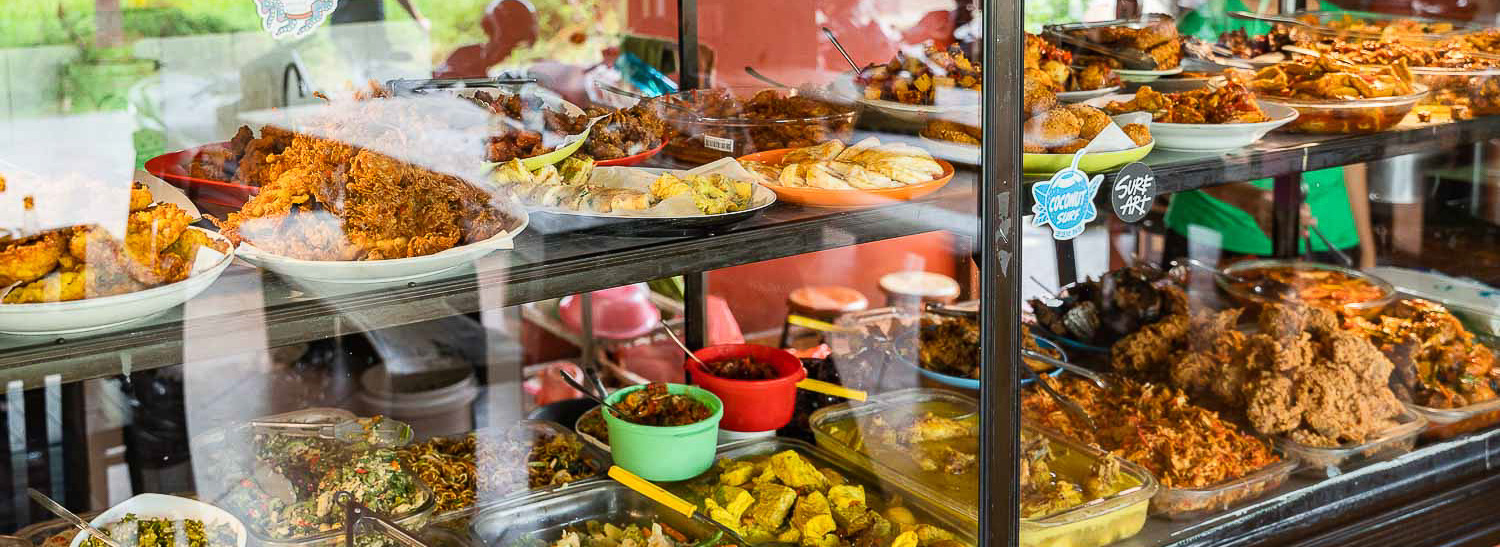
- Nasi Goreng: Indonesia’s ubiquitous fried rice, typically featuring a medley of fresh vegetables, a choice of meat (chicken, beef, or seafood), and a blend of aromatic spices.
- Mie Goreng: The noodle counterpart to Nasi Goreng, this stir-fried dish uses yellow wheat noodles, vegetables, and meat, often with a hint of sweetness from kecap manis (sweet soy sauce).
- Sate Lilit: A Balinese specialty, these grilled skewers are made from minced meat, fish, or even vegetables, mixed with a rich blend of spices and wrapped around a lemongrass stalk or bamboo stick.
- Bebek Betutu & Ayam Betutu: Slow-roasted duck and chicken, respectively, cooked with a complex mixture of Balinese spices, often wrapped in banana leaves or an areca palm frond.
- Babi Guling: The star of Balinese cuisine, a whole roasted suckling pig, celebrated for its crispy skin and tender, flavorful meat.
- Lawar: A salad made with finely chopped vegetables, minced meat (often pork, chicken, or duck), grated coconut, and a potent mix of herbs and spices.
- Gado-Gado: A popular Indonesian salad featuring blanched or steamed vegetables, hard-boiled eggs, fried tofu, tempeh, and lontong (rice cakes), all smothered in a rich peanut sauce.
- Karedok: Similar to Gado-Gado but typically made with raw vegetables, offering a different textural experience.
- Rujak: A refreshing and spicy fruit salad, often with unripe fruits, served with a dressing made from palm sugar, chili peppers, and sometimes shrimp paste.
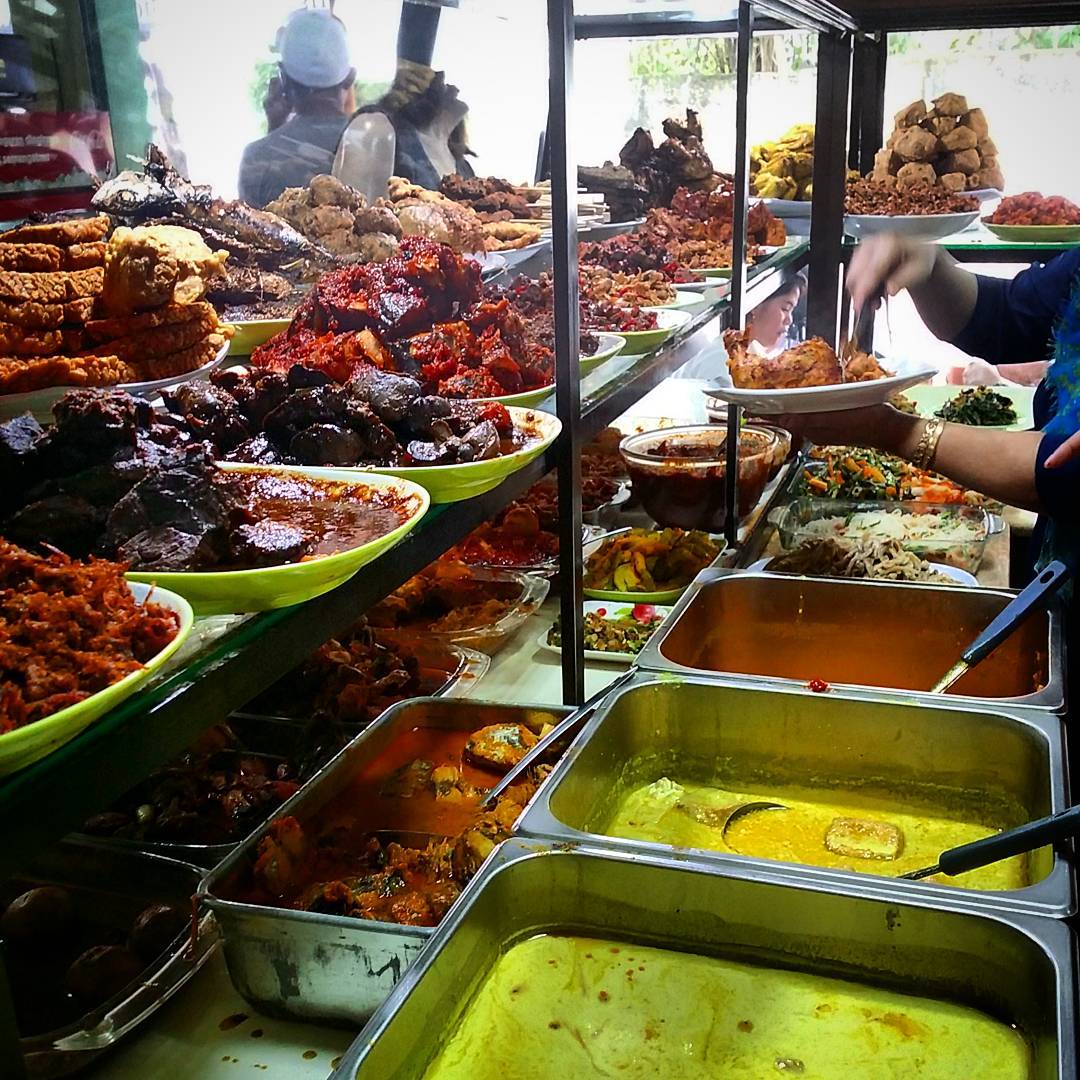
Visiting a warung is an essential part of any Bali food itinerary. It offers an authentic taste of Indonesian cuisine, prepared with fresh ingredients and served in a casual, welcoming environment. For those seeking to truly immerse themselves in the local culture, a warung experience is simply indispensable. These local restaurants are where you’ll find the most authentic traditional Balinese dish.
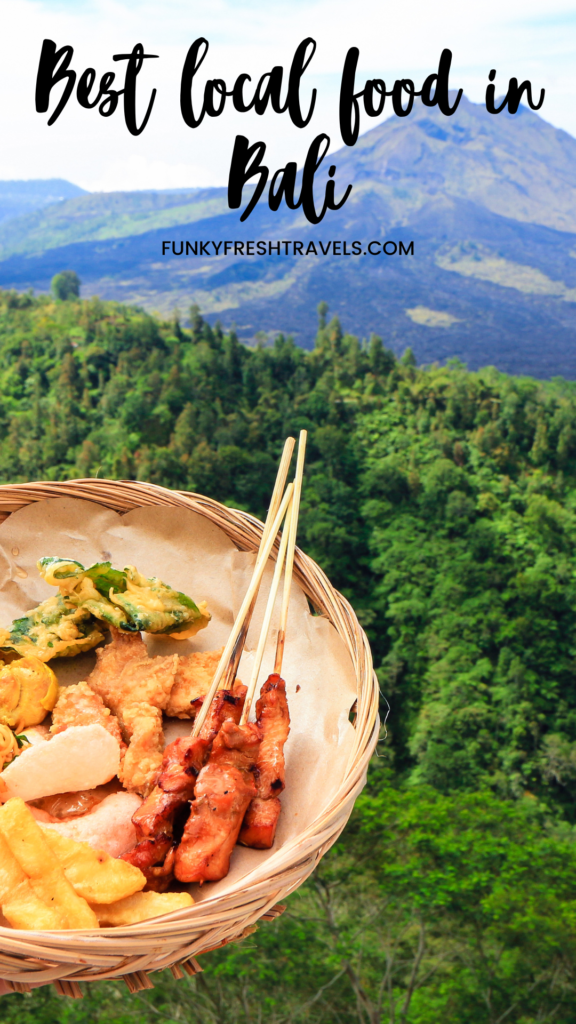


Don’t forget to check our complete guide about Bali, Canggu, Seminyak and other cities . Restaurants, Yoga, breakfasts, bars … And much more !


A Deep Dive into Balinese Traditional Food: Must-Try Dishes
Bali’s culinary landscape is rich with flavors, aromas, and textures. Here’s a closer look at some of the island’s most iconic and delectable traditional dishes:
1. Babi Guling

Babi Guling, or roast suckling pig, stands as a culinary emblem of Bali, a dish that starkly differentiates Balinese cuisine from the predominantly halal food found in other parts of Indonesia. Historically, Babi Guling was a celebratory dish reserved for significant religious events or sizable gatherings and special occasions. However, with the surge in tourism, its popularity has soared, and many Balinese restaurants now serve it daily, allowing visitors to experience this magnificent culinary tradition and understand why it’s considered the best food of its kind.
Preparation: The preparation of Babi Guling is an elaborate and time-honored process. A whole young pig (babi) is meticulously cleaned and stuffed with a potent blend of traditional Balinese spices known as bumbu genep (a rich paste of turmeric, coriander, lemongrass, black pepper, garlic, shallots, ginger, and chili peppers). The pig’s skin is often rubbed with coconut water and turmeric to achieve its signature golden-brown hue and incredible crispiness. It is then slow-roasted on a rolling spit over an open flame, typically fueled by coconut husks or wood, for several hours. This slow-roasting process ensures the meat is incredibly tender and infused with the aromatic spices, while the skin develops a delightful crackling texture. This dedication makes it a truly traditional Balinese dish.
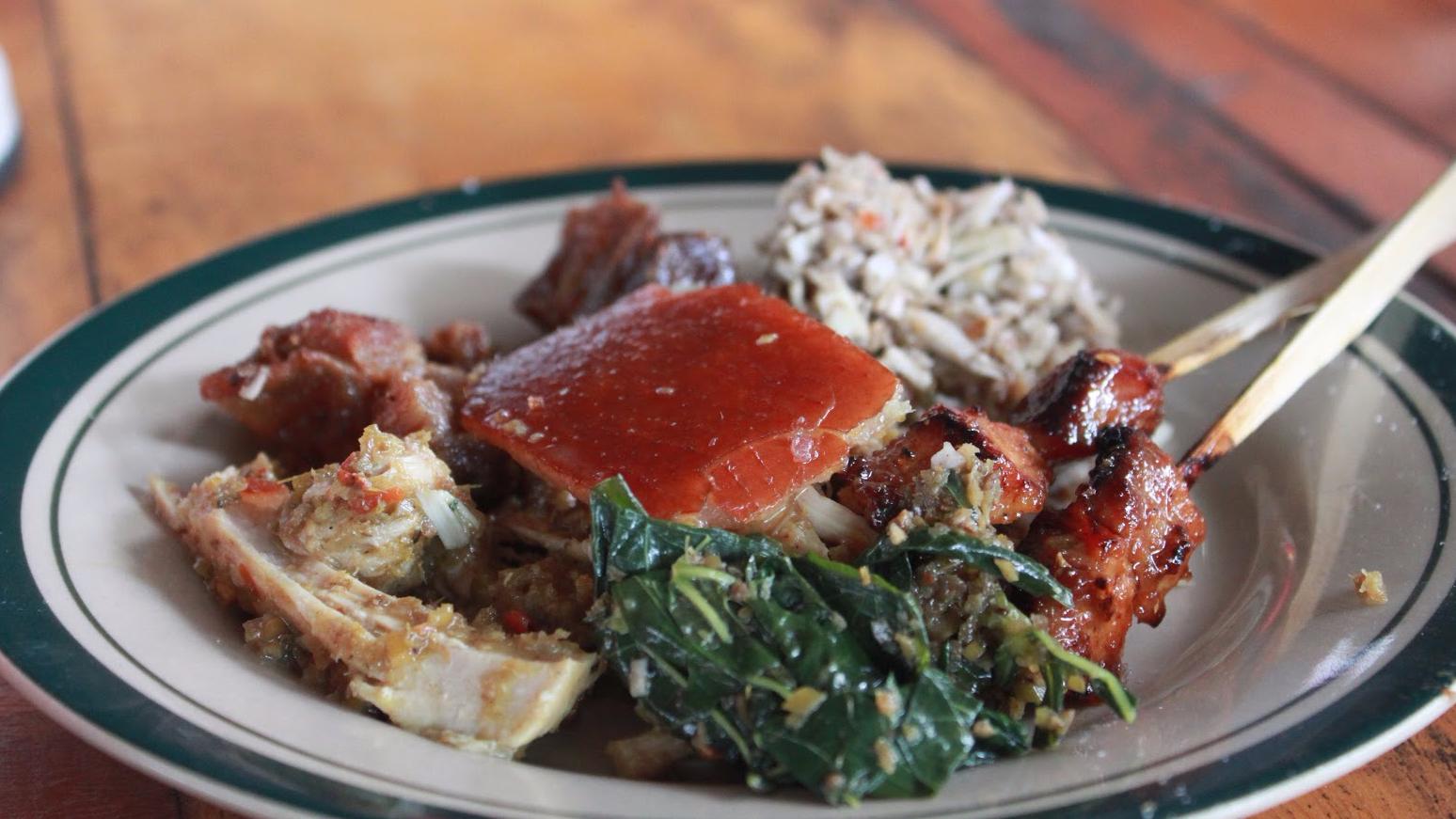
Serving: Once perfectly cooked, the Babi Guling is expertly carved and served with steamed white rice, a side of lawar (spiced vegetable and meat salad), urutan (Balinese pork sausage), crispy pork crackling, and a fiery sambal matah. The combination of succulent meat, crunchy skin, and vibrant side dishes creates a symphony of flavors and textures that is truly unforgettable. For many, experiencing Babi Guling is a highlight of their Bali food adventure, showcasing the excellence of pork dishes on the island.
2. Nasi Campur Bali
Nasi Campur, literally meaning “mixed rice,” is a ubiquitous dish found throughout Indonesia, but the Balinese rendition holds a special allure. It’s essentially a customizable sampling platter, where steamed white rice is accompanied by an assortment of small portions of various Balinese side dishes. Each warung or chef will have their unique combination, making every Nasi Campur experience slightly different and exciting. It’s a fantastic way to explore the diverse Bali diet.
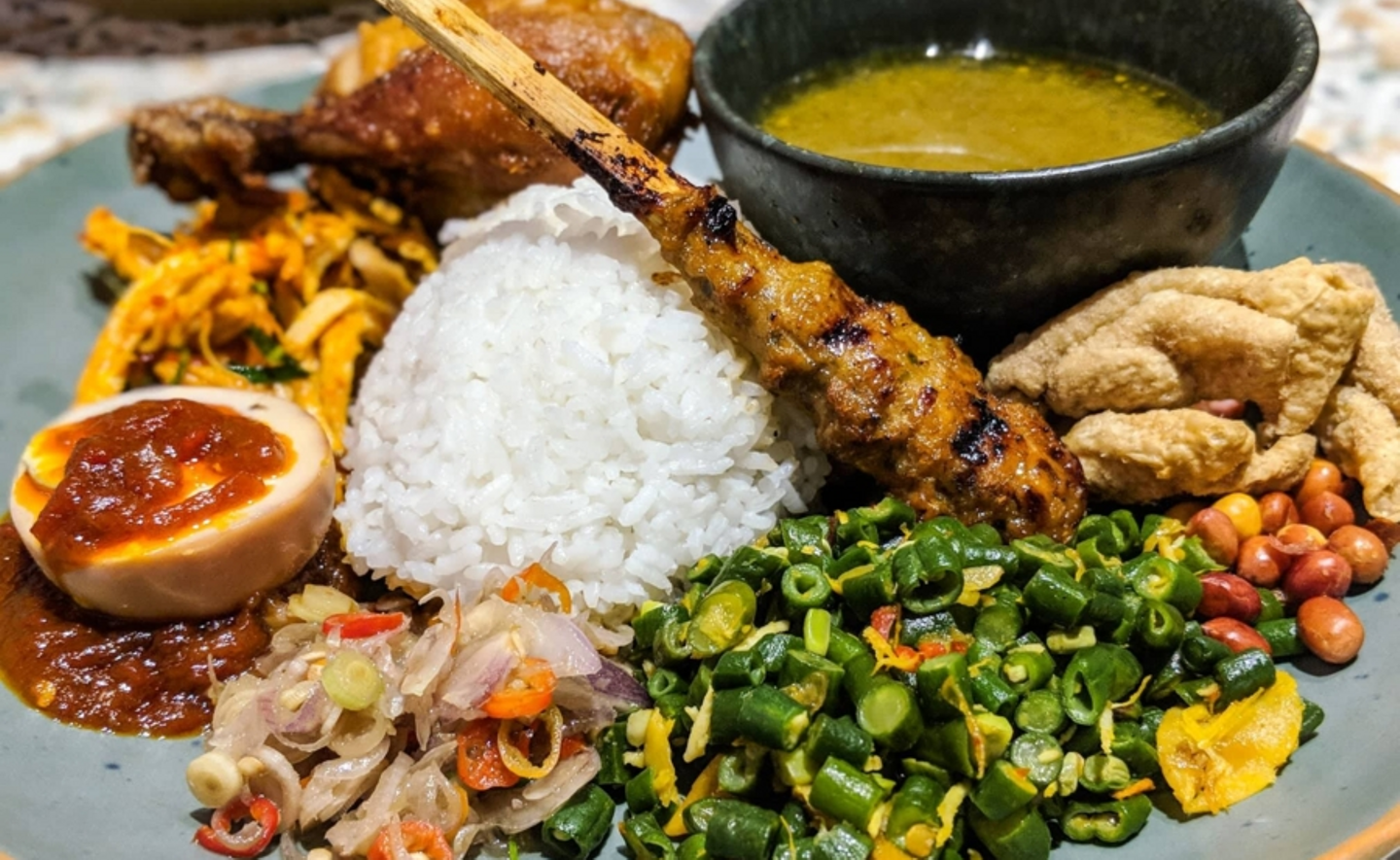
Preparation: The core of Nasi Campur is steamed rice. The side dishes are prepared separately, often involving grilling chicken or beef, frying tofu and tempeh (fermented soybean cakes), blanching or stir-frying fresh vegetables, and preparing various sambals. Common accompaniments include:
- Ayam Sisit: Shredded grilled chicken, often spiced with turmeric and chili.
- Sate Lilit: Minced meat or fish skewers.
- Lawar: Spiced vegetable and meat salad.
- Telur Balado: Hard-boiled egg in a spicy chili peppers sauce.
- Tempe Manis: Sweet and savory fried tempeh.
- Sayur Urab: Steamed vegetables mixed with spiced grated coconut.
- Sambal Matah/Sambal Embe: Fresh chili and shallot salsa.
Serving: The beauty of Nasi Campur lies in its versatility. You choose your preferred side dishes, and they are artfully arranged around a mound of rice. It’s often topped with a fried egg and a generous dollop of sambal, allowing you to mix and match flavors with each bite. Nasi Campur Bali is a fantastic way to sample a wide range of Balinese flavors in a single meal, making it a must-try for culinary explorers and a prime example of best local food Bali.
3. Tum Ayam: Spiced Chicken in Banana Leaves
Tum, along with Pepes (another banana leaf wrapped dish), showcases a traditional Balinese cooking method where ingredients are encased in banana leaves before being steamed or grilled. Tum Ayam specifically refers to finely minced chicken mixed with a complex blend of Balinese spices. This traditional Balinese dish highlights the ingenuity of local cooking.

Preparation: The key to Tum Ayam’s flavor is the bumbu genep, the all-encompassing Balinese spice paste. This paste, a cornerstone of Balinese cuisine, typically includes ingredients like shallots, garlic, chili peppers, ginger, turmeric, galangal, kencur, lemongrass, and kaffir lime leaves. The finely minced chicken is thoroughly mixed with this aromatic spice paste. The mixture is then carefully spooned onto a piece of banana leaf, folded into a neat parcel, and secured with a toothpick or a small bamboo skewer. The parcels are then steamed (or sometimes lightly grilled) until the chicken is cooked through and the flavors have deeply permeated the dish.
Serving: Tum Ayam is usually served as a side dish with steamed rice, offering a burst of aromatic and subtly spicy flavor. The banana leaf wrapper not only infuses the dish with a delicate aroma but also helps retain moisture, keeping the chicken tender and flavorful.
4. Nasi Goreng: Indonesia’s Iconic Fried Rice
Nasi Goreng holds the unofficial title of Indonesia’s national dish and is a staple found in virtually every corner of Bali, from humble street food stalls to upscale restaurants. It’s an incredibly versatile and satisfying meal, available at any time of day or night and remarkably affordable. It’s often considered the best food for a quick and satisfying meal within the Bali diet.

Preparation: At its core, Nasi Goreng is stir-fried rice. Leftover rice is ideal for this dish as it’s drier and less likely to clump. The rice is stir-fried in a wok with a blend of aromatics like garlic, shallots, and chili peppers. Key seasonings include sweet soy sauce (kecap manis), fish sauce, and sometimes shrimp paste (terasi) for an umami depth. Common additions include diced chicken, shrimp, fresh vegetables like carrots and green beans, and scrambled egg.
Serving: Nasi Goreng is often served with a fried egg on top, a few slices of cucumber and tomato, krupuk (crispy crackers), and sometimes a side of sate or acar (pickled vegetables). Its simplicity, delicious flavor, and widespread availability make Nasi Goreng an essential Balinese food experience.
5. Mie Goreng: The Flavorful Fried Noodles
Following closely on the heels of Nasi Goreng is its equally popular cousin, Mie Goreng, or stir-fried noodles. This dish shares similarities with Chinese chow mein but has a distinct Indonesian character, particularly with the inclusion of kecap manis and local spices.

Preparation: Traditional Mie Goreng uses yellow wheat noodles, which are stir-fried with a similar array of aromatics to Nasi Goreng – shallots, garlic, and chili peppers. The sauce base typically includes kecap manis, soy sauce, and sometimes a dash of oyster sauce. Common additions include scrambled egg, slices of chicken, beef, or seafood (shrimp or squid), and various fresh vegetables like cabbage, bok choy, and bean sprouts. Its immense popularity even inspired the creation of Indomie, one of the world’s most famous instant ramen brands.
Serving: Like Nasi Goreng, Mie Goreng is often garnished with a fried egg, krupuk, and fresh cucumber and tomato slices. It’s a hearty and flavorful dish that’s perfect for a quick and satisfying meal.
6. Es Campur: A Refreshing Tropical Dessert
In the tropical heat of Bali, Es Campur (mixed ice) is a welcome respite. This colorful and refreshing dessert is perfect for cooling down and satisfying a sweet craving. It’s a delightful end to any meal, showcasing the sweet side of the Bali diet.
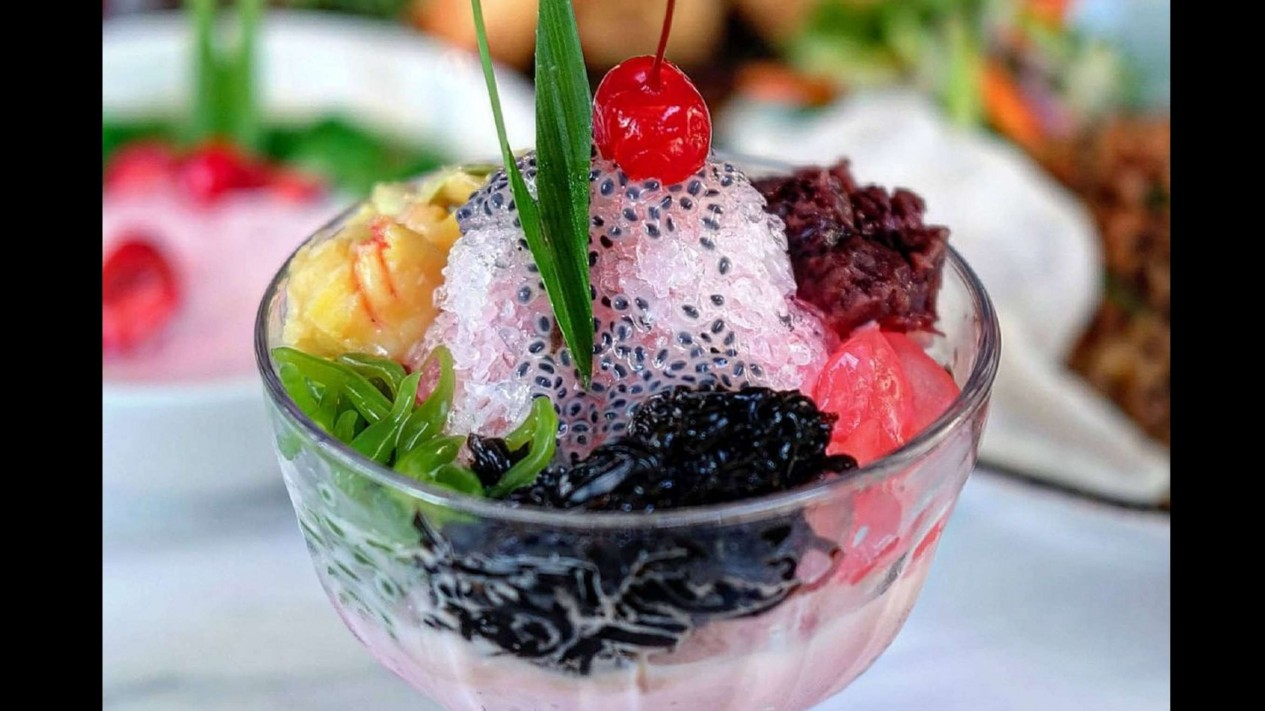
Preparation: The base of Es Campur is a generous mound of finely shaved ice. This is then topped with a delightful array of colorful and textured ingredients, which can vary but often include:
- Avocado: Creamy and subtly sweet.
- Nata de Coco: Chewy coconut jelly.
- Grass Jelly (Cincau): Dark, slightly bitter jelly that provides a refreshing contrast.
- Basil Seeds (Biji Selasih): Tiny, gelatinous seeds that absorb flavor.
- Fermented Cassava (Tape Singkong): Soft, slightly tangy, and sweet.
- Jackfruit (Nangka): Sweet and aromatic.
Once the toppings are assembled, a generous pour of coconut milk or evaporated milk is added, followed by a drizzle of vibrant syrup (often coco pandan or rose syrup) and a swirl of sweet condensed milk for extra richness.
Serving: Es Campur is typically served in a tall glass or bowl, allowing the diner to mix the ingredients together. It’s a playful and delicious dessert that’s widely available from street vendors to more formal restaurants.
Other Indonesian Specialties to Explore
While the list above covers some of the most prominent Balinese dishes, the island’s culinary repertoire extends much further. Here are a few more Indonesian specialties you shouldn’t miss during your Bali food exploration:
Don’t forget to check our complete guide about Bali, Canggu, Seminyak and other cities . Restaurants, Yoga, breakfasts, bars … And much more !
7. Jimbaran Seafood
Due to the island’s proximity to the ocean, seafood naturally plays a significant role in its cuisine. Delicious seafood can be found all around Bali, but Jimbaran Beach is renowned as the ultimate destination for a memorable seafood feast. Along the picturesque bay, numerous beachfront local restaurants and market stalls offer an incredible array of freshly caught fish and shellfish.

Experience: The Jimbaran seafood experience typically involves choosing your desired seafood directly from tanks or ice displays. Options often include snapper, prawns, squid, lobster, and various other local catches. The selected seafood is then expertly grilled over coconut husks, imparting a unique smoky flavor. The simple preparation allows the natural sweetness and freshness of the seafood to shine. This is a must-try for the best food in seafood.
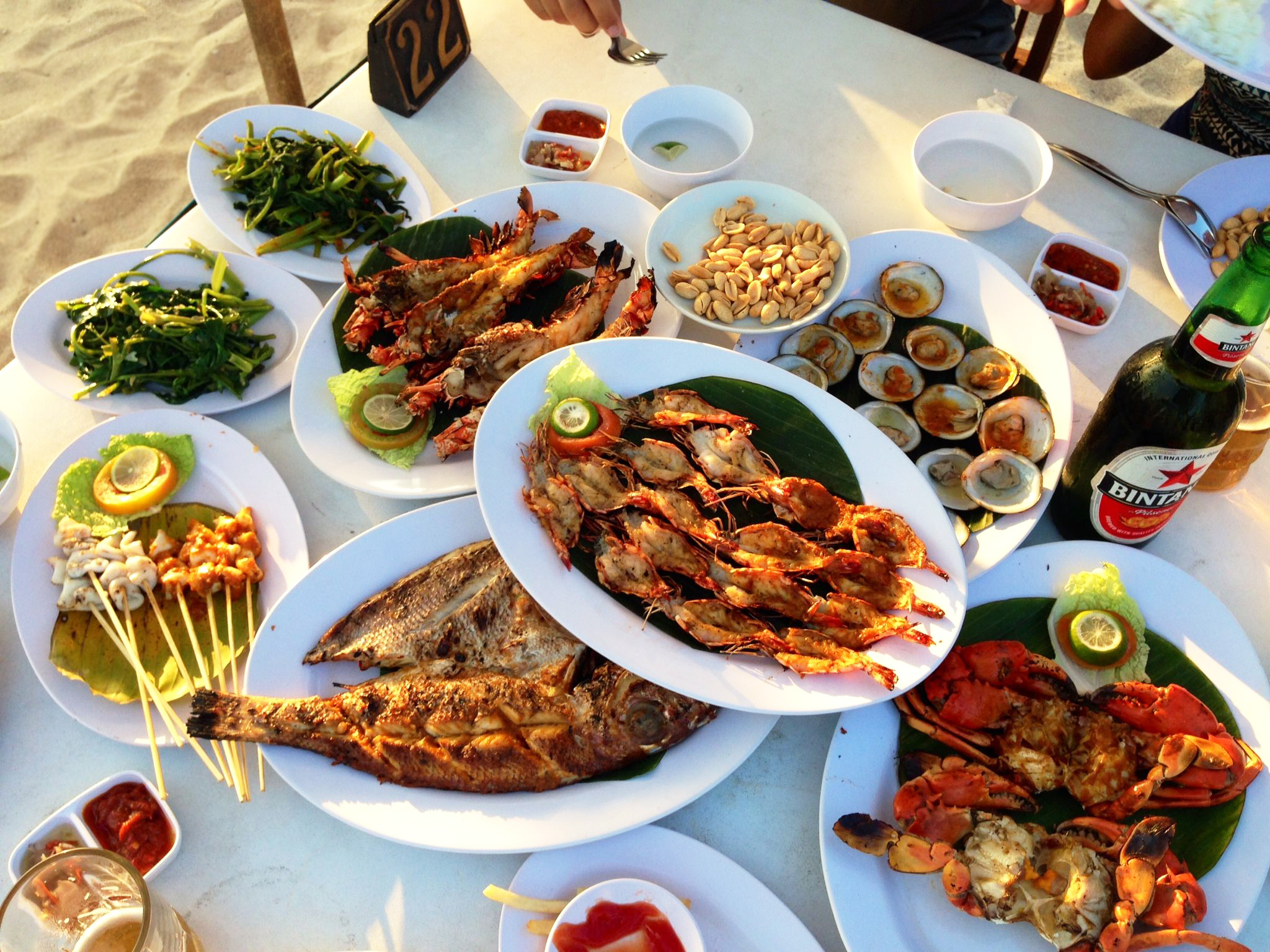
Serving: The grilled seafood is usually served with a basket of steamed rice, a selection of sambals (chili sauces), and sometimes a simple side salad. The ideal time to visit Jimbaran Beach is in the late afternoon or early evening. Tables are often set directly on the sand, offering breathtaking views of the sunset as you enjoy your meal, making it a truly immersive and romantic dining experience at one of the prime local restaurants
8. Sambal Matah: Bali’s Fresh Chili Salsa
In Balinese cuisine, Sambal Matah is a significant and frequently used Indonesian sauce or salsa. Its unique freshness sets it apart from cooked sambals. Chefs’ recipes differ, but the usual ingredients are garlic, chili peppers, lemongrass, and kaffir lime leaves. It may occasionally also include additional ingredients like shallots, coconut oil, and shrimp paste, often brightened with a squeeze of lime juice.

Preparation: The preparation of Sambal Matah is relatively simple, yet the combination of fresh ingredients creates a complex and pungent flavor. The core ingredients typically include finely sliced shallots, lemongrass, and green and red bird’s eye chilies. Kaffir lime leaves are often added for a citrusy aroma. These ingredients are then lightly bruised and mixed with a generous amount of hot coconut oil and a pinch of salt. Some variations may include a touch of shrimp paste (terasi) for added depth.
Serving: Sambal Matah is served as a fresh condiment alongside a myriad of Balinese dishes, particularly grilled meats and seafood. It’s also frequently used as a marinade or a base for other preparations. Its zesty, spicy, and fragrant notes cut through richness and elevate the flavor of any dish it accompanies. Be prepared for its fiery kick! This essential condiment is a testament to the flavorful Bali diet.
9. Bubur Sumsum: Sweet Rice Porridge Dessert
Although it can be eaten for breakfast or as a snack, Bubur Sumsum is frequently served as a traditional dessert. The essential ingredients in this dish are coconut milk, rice flour, and palm sugar syrup on top. Sweet potato dumplings are occasionally served with bubur sumsum. It’s a soothing and sweet example of the best food for a gentle start or a pleasant finish.

Preparation: This creamy porridge is made from rice flour, cooked slowly with coconut milk until it reaches a smooth, velvety consistency. The magic lies in the accompanying palm sugar syrup (gula merah cair), which is usually cooked down until it’s thick and rich. Some variations may also include sweet potato dumplings (biji salak) for added texture.
Serving: Bubur Sumsum is typically served warm, with a generous drizzle of the dark, aromatic palm sugar syrup over the white coconut milk porridge. The contrast in color and flavor makes it visually appealing and deliciously comforting.
10. Pisang Goreng: The Beloved Fried Banana
Pisang Goreng, literally “fried banana,” is a ubiquitous and incredibly popular sweet snack found throughout Indonesia and Southeast Asia. It’s a simple yet highly addictive treat that can be found everywhere from street vendors to cafes and local restaurants. It’s easily one of the best food options for a quick sweet fix.

Preparation: Ripe bananas (often plantains or local varieties like Pisang Kepok) are coated in a light batter, sometimes flavored with a hint of vanilla or cinnamon, and then deep-fried until golden brown and crispy on the outside, and soft and sweet on the inside.
Serving: Pisang Goreng can be enjoyed on its own as a delightful snack. While not traditional, pairing it with a scoop of vanilla ice cream offers a wonderful contrast of warm and cold, and crispy and creamy textures.
And much more !
The culinary journey in Bali is vast and exciting. Beyond these highlights, you’ll encounter numerous other delights that contribute to the rich Bali diet:

- Gado-Gado: A beloved Indonesian salad with a rich peanut sauce.
- Nasi Jinggo: Small, affordable portions of rice with various accompaniments, often wrapped in banana leaves.
- Basa Gede: A fundamental Balinese spice paste, similar to bumbu genep, that forms the base of many dishes.
- Pepes Ikan: Steamed or grilled fish wrapped in banana leaves with spices.
- Sate Lilit: Minced fish or meat skewers.
- Ikan Bakar: Grilled fish, typically marinated in a spicy-sweet sauce.
- Kopi Luwak: The world-renowned, albeit controversial, civet coffee.
Just remember, when it comes to chili peppers and spicy food in Bali, don’t go too hard on the chili sauce unless you’re accustomed to the heat! The Balinese people are known for their love of spice.
Don’t forget to check our complete guide about Bali, Canggu, Seminyak and other cities . Restaurants, Yoga, breakfasts, bars … And much more !
Looking what to do in Bali ? I wrote more than 50 articles about Bali Best temples in Bali Best diving Best festivals Where to stay in Bali
Discovering the Best Traditional Restaurants in Bali (Local Warungs)
While many upscale restaurants offer fantastic dining experiences, to truly savor the best local food Bali has to offer, venturing into traditional warungs is essential. These local restaurants embody the authentic culinary spirit of the island.
:max_bytes(150000):strip_icc()/babi_guling2-5b71288c46e0fb00256bd603.jpg)
- Warung Babi Guling Ibu Oka 2 (Ubud): This is arguably the most famous warung for Babi Guling. Located in a traditional Balinese compound, it offers a truly authentic setting to try this iconic pork dish. It’s a must-visit for a traditional Balinese dish.
- Nasi Ayam Kedewatan Ibu Mangku (Petitenget, Seminyak): Famous for its delicious Nasi Ayam, this warung serves chicken cooked in a flavorful broth with various traditional Balinese side dishes. Its setting amidst rice fields adds to the charm.
- Bebek Bengil (Ubud): Known for its “dirty duck” (bebek bengil), a slow-cooked, fall-off-the-bone tender duck with a rich sauce. The setting with views of the Ayung River enhances the dining experience.
- Mozaic Restaurant (Ubud): While more upscale, Mozaic offers a modern interpretation of traditional Balinese cuisine, showcasing beautifully presented dishes. It’s an excellent choice if you’re looking for a refined take on traditional Balinese dish concepts.
- Sardine (Seminyak): Specializing in fresh seafood, Sardine grills its catches to perfection. It offers a more refined seafood experience than Jimbaran, with attentive staff and a stylish setting.
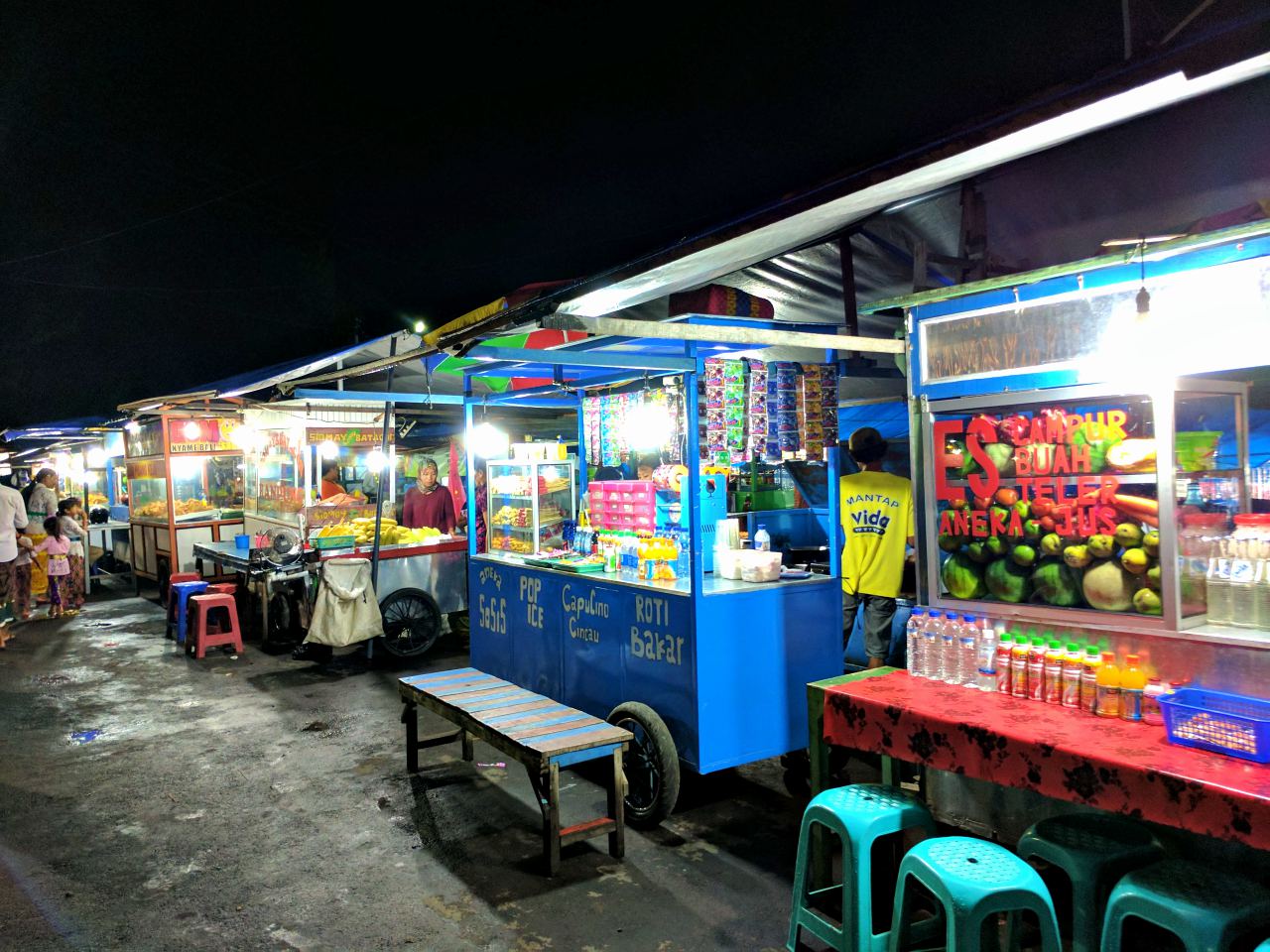
For a truly 100% traditional warung experience, often the best food is found by simply walking into any local warung on your street. These smaller, unlisted establishments often serve incredible, authentic food and are frequented by the Balinese people. They might not have a Google Maps profile or a website, but they offer an unparalleled taste of the local culinary scene.
Don’t forget to check our complete guide about Bali, Canggu, Seminyak and other cities . Restaurants, Yoga, breakfasts, bars … And much more!
In our restaurant guide you will find local Indonesian places, cities by cities
Looking what to do in Bali ? I wrote more than 50 articles about Best cities in Bali , or discover How much is a trip to Bali , or visit Best waterfalls in Bali and Romantic getaway Bali . Are you thinking Is it safe to travel to Bali ?
Navigating Bali Belly: Staying Healthy on Your Culinary Adventure

While exploring the delightful Bali diet, it’s important to be mindful of “Bali Belly,” a common illness affecting travelers to Southeast Asia. Caused by bacteria like Escherichia coli (E. coli), it can contaminate food and water, leading to symptoms like diarrhea, vomiting, abdominal pain, and fever. In severe cases, dehydration and hospitalization can occur. Taking precautions allows you to enjoy the best food without worry.

How to Avoid Bali Belly:
- Hand Hygiene: Wash your hands frequently with soap and water, especially before eating. This is the most crucial step in preventing bacterial spread.
- Street Food Caution: While delicious, street food can sometimes pose a risk if not cooked properly or hygienically. Opt for vendors with high turnover, where food is cooked fresh in front of you and served hot.
- Water Safety: Only drink bottled water or water that has been boiled. Tap water in Bali is generally not safe for consumption. Be cautious of ice cubes, unless assured they are made from purified water.
- Cooked Food Only: Avoid raw or undercooked meat and seafood. Ensure all food is thoroughly cooked and served hot. Salads should generally be avoided unless you’re confident they’ve been washed with purified water.
- Vaccinations: Consider getting vaccinated against Hepatitis A and Typhoid before your trip, as these can help protect you from common causes of Bali Belly.
- Fruit and Vegetables: Stick to fruits you can peel yourself (like bananas or mangoes). For fresh vegetables, ensure they are cooked.

Treating Bali Belly:
If you do experience Bali Belly, these steps can help:
- Hydration: Rest and drink plenty of fluids (bottled water, oral rehydration solutions like Pocari Sweat) to prevent dehydration caused by diarrhea and vomiting.
- Bland Diet: Eat a bland diet. Avoid spicy, greasy, or dairy foods, which can irritate your stomach. Stick to plain rice, toast, and clear broths.
- Over-the-Counter Medications: Over-the-counter medications like loperamide (Imodium) for diarrhea or anti-emetics for vomiting can help alleviate symptoms. Always follow dosage instructions.
- Seek Medical Attention: If your symptoms are severe, include high fever, blood in stool, or do not improve after a few days, consult a doctor immediately. Local clinics and hospitals in Bali are equipped to handle such cases.
By following these guidelines, you can significantly reduce your risk of Bali Belly and fully immerse yourself in the incredible flavors and culinary adventures that Bali has to offer. Enjoy discovering the best food and the unique Bali diet safely!
Don’t forget to check our complete guide about Bali, Canggu, Seminyak and other cities . Restaurants, Yoga, breakfasts, bars … And much more !


I wrote more than 50 articles about Bali Best travel blogs in Bali with best itinerary Best places to party in bali or Best vegans restaurants in Bali
Finally
Balinese food is a fusion of flavours that is supported by the special aromatic spice blends they utilize. The food in the province varies depending on where you go, and it truly offers a distinctive culinary experience from the rest of Indonesia. There is bound to be something in Bali to intrigue and please your palate, whether it be street cuisine like laklak or sate, heartier dishes like babi guling or nasi campur, or just the underlying spices of sambal matah.
This list, however, only scratches the surface of the mouthwatering culinary pleasures Bali has to offer. In order to get a better idea of what real Balinese cuisine is like, it is worthwhile to venture outside of the island’s popular tourist destinations and explore the local markets.

WHO AM I ?
Hello !
I am Eric, a French Australian citizen based between Australia, Asia and Bali an I love to travel and experience the world. I generally like outdoor activities, wellness, great food and venues , party and real local adventures ! I am a Yoga practitioner and fitness lover
I created this blog because I love to travel and I want to share my experiences with others. I’ve been traveling since I was a child, and I’ve been to over 50 countries. I’ve seen some amazing things and met some amazing people, and I want to help others experience the same things.
I believe that travel is one of the best ways to learn about the world and about yourself. When you travel, you’re forced to step outside of your comfort zone and experience new things. You learn about different cultures, different religions, and different ways of life. You also learn about yourself, your strengths, and your weaknesses.

Travel can also be a great way to make new friends. When you’re travelling, you’re surrounded by people from all over the world, and you’re all in the same boat. You’re all there to explore and experience new things, and that can create a bond between people.
Let’s connect together !

Taj Mahal, Agra, India

